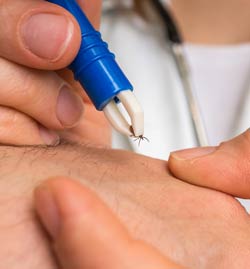 Have Some Hot Fun in the Summertime — Just Be Careful
Have Some Hot Fun in the Summertime — Just Be Careful
“Hot Fun in the Summertime” is a great oldies tune, but working outdoors in the summer means being aware of old and new dangers to work — and play — safely.
Deer ticks: Tiny eight-legged creatures, as small as a poppy or sesame seed, pack a big wallop: the Borrelia burgdorferi bacterium that causes Lyme disease.  Most common in the Northeast and upper Midwest, tick bites cause some 30,000 cases of Lyme disease each year, with many more unreported. The CDC estimates about 300,000 Americans suffer from Lyme disease. Most common in the Northeast and upper Midwest, tick bites cause some 30,000 cases of Lyme disease each year, with many more unreported. The CDC estimates about 300,000 Americans suffer from Lyme disease.
Symptoms of Lyme disease can include fever, headache, muscle or joint pain and extreme fatigue. Some folks barely notice the tell-tale expanding bulls-eye-like red rash, since it’s not painful or itchy. Untreated, the Lyme disease infection can spread and cause rashes, nerve problems, arthritis or other disorders. Although most people recover with antibiotics, the best solution is prevention.
Summer is a prime time for ticks, so be sure to wear long sleeves, long pants and long socks when working or playing outdoors. You don’t need to be in deep woods areas for there to be ticks; they are present even in short, regularly mowed areas. To protect against them with insect spray, you need to use one with at least 20-percent DEET on your skin or permethrin on your clothes.
 Heat Illness: Since 2011, the Occupational Safety and Health Administration has promoted a Heat Illness Prevention campaign to protect workers from heat. Its safety message boils down to — Water. Rest. Shade. Heat Illness: Since 2011, the Occupational Safety and Health Administration has promoted a Heat Illness Prevention campaign to protect workers from heat. Its safety message boils down to — Water. Rest. Shade.
The range of heat illnesses (heat cramps, heat exhaustion or heat stroke) can affect anyone, regardless of age or physical condition. Although the elderly, the very young, those with certain medical conditions or those taking certain medications are most at risk, Exertional Heat Stroke (EHS) can happen to anyone if they are working outdoors, engaged in strenuous activity or wearing heavy gear.
Although summer days are drawing to a close, warm weather during fall activities occurs regularly as well. Monitor the heat index and encourage employees to take breaks, rest in the shade and stay hydrated. Use these PDRMA resources to help keep staff safe and well when working outdoors.
PDRMA Resources:
|

